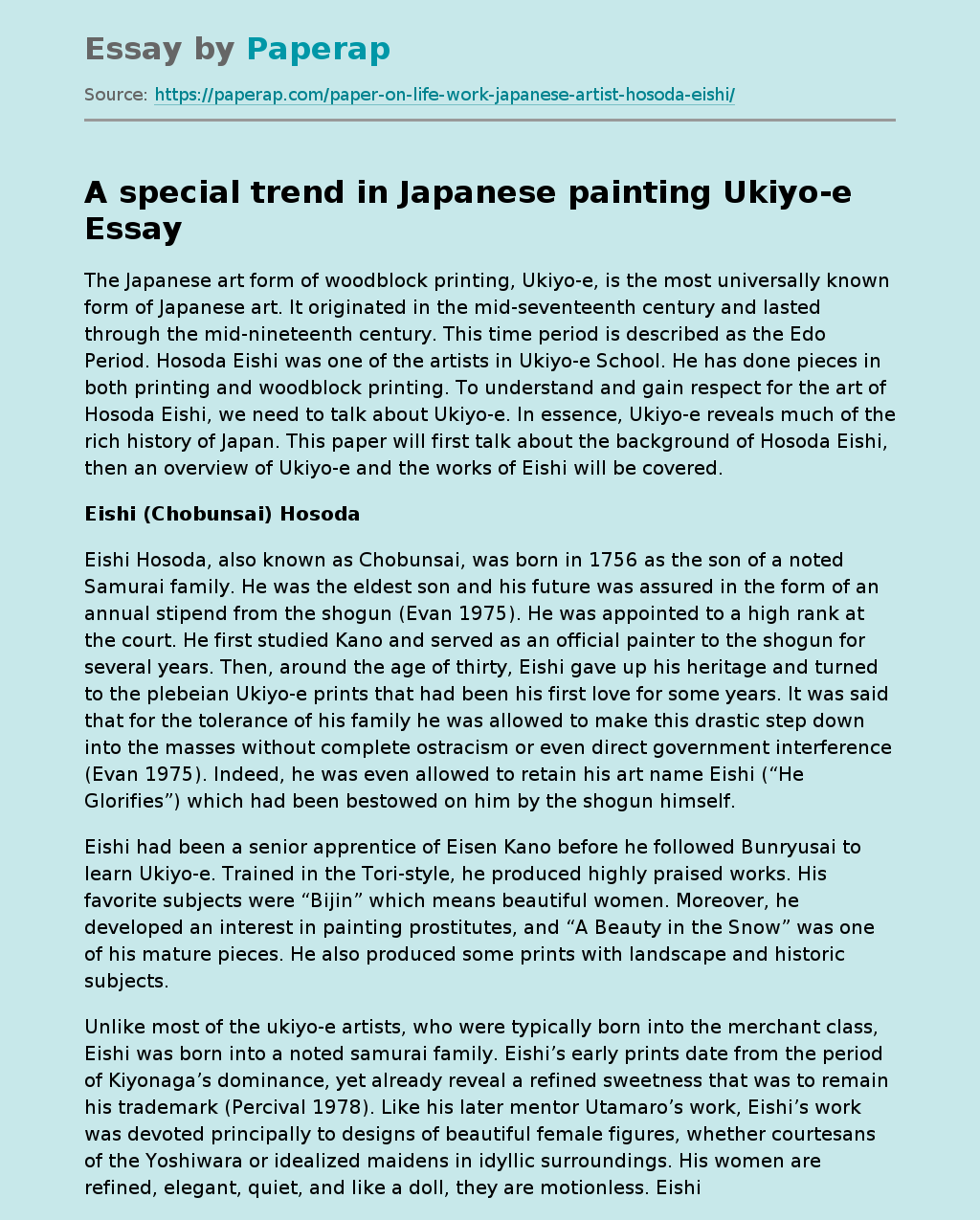A special trend in Japanese painting Ukiyo-e
The Japanese art form of woodblock printing, Ukiyo-e, is the most universally known form of Japanese art. It originated in the mid-seventeenth century and lasted through the mid-nineteenth century. This time period is described as the Edo Period. Hosoda Eishi was one of the artists in Ukiyo-e School. He has done pieces in both printing and woodblock printing. To understand and gain respect for the art of Hosoda Eishi, we need to talk about Ukiyo-e. In essence, Ukiyo-e reveals much of the rich history of Japan.
This paper will first talk about the background of Hosoda Eishi, then an overview of Ukiyo-e and the works of Eishi will be covered.
Eishi (Chobunsai) Hosoda
Eishi Hosoda, also known as Chobunsai, was born in 1756 as the son of a noted Samurai family. He was the eldest son and his future was assured in the form of an annual stipend from the shogun (Evan 1975). He was appointed to a high rank at the court.
He first studied Kano and served as an official painter to the shogun for several years. Then, around the age of thirty, Eishi gave up his heritage and turned to the plebeian Ukiyo-e prints that had been his first love for some years. It was said that for the tolerance of his family he was allowed to make this drastic step down into the masses without complete ostracism or even direct government interference (Evan 1975). Indeed, he was even allowed to retain his art name Eishi (“He Glorifies”) which had been bestowed on him by the shogun himself.
Eishi had been a senior apprentice of Eisen Kano before he followed Bunryusai to learn Ukiyo-e. Trained in the Tori-style, he produced highly praised works. His favorite subjects were “Bijin” which means beautiful women. Moreover, he developed an interest in painting prostitutes, and “A Beauty in the Snow” was one of his mature pieces. He also produced some prints with landscape and historic subjects.
Unlike most of the ukiyo-e artists, who were typically born into the merchant class, Eishi was born into a noted samurai family. Eishi’s early prints date from the period of Kiyonaga’s dominance, yet already reveal a refined sweetness that was to remain his trademark (Percival 1978). Like his later mentor Utamaro’s work, Eishi’s work was devoted principally to designs of beautiful female figures, whether courtesans of the Yoshiwara or idealized maidens in idyllic surroundings. His women are refined, elegant, quiet, and like a doll, they are motionless. Eishi’s women do not show their feelings. It is said, that was because Eishi was a samurai, his view of women was strongly influenced by the ideal of samurai women (Percival 1978). He was also a master of erotica. Eishi was not only one of the most successful and popular artists of his day, but was also a very influential teacher who had many pupils and followers.
History of Ukiyo-e
“Ukiyo-e” is traditional wood-block printing art of Japan. The appealing art of the Ukiyo-e woodblock print is undoubtedly the most universally known of all Japanese arts. This particular style of art flourished in Japan during the period from the mid-seventeenth to the mid-nineteenth century.
The word “Ukiyo” was originated from a Buddhism term “this transitory world” lasting for one’s life until death. However, the meaning was changed later with an optimistic view of life that one should enjoy his life anyhow one passed through the transitory world, while the word “e” means a picture or drawing (Percival 1978). The art of Ukiyo-e, now usually means “pictures of the floating world”, originated in the metropolitan culture of Edo (modern day Tokyo) during the period of Japanese history when the political and military power was in the hands of the shoguns, and the country was virtually isolated from the rest of the world. It is an art closely connected with the pleasures of theatres, restaurants, teahouses, geisha and courtesans (Pekarik 1991). Also Ukiyo-e took on the role of mass media for the community. Many Ukiyo-e prints were in fact posters, advertising theatre performances or idol portraits of popular actors and beautiful teahouse girls. But this more or less sophisticated world of urban pleasures was also animated by the traditional Japanese love of nature.
Some of the popular art pieces by Eishi are “The Thirty-Six Immortal Women Poets” which is a poetry album with illustrations by Eishi, “Shizuka in the Shizutama-ya”, which was made around 1794 or 1795 when his art was at its best. It is from the set, “Six Select Beauties in the Gay Quarters (Seiro Bijin Rokkasen)”, “Courtesan on a Spring Evening” and “Oiran with Two Kamuro Strolling under a Cherry Tree” were both handscrolls with ink and colour on silk. Some woodblock prints like “Kisen Hoshi”, from the series “Six Immortal Poets”, Echizenya Morokoshi, from the series “Six Beauties from the Pleasure Quarter” and “Hanogi, Yoshino and Tatsuta” from the Ogiya Establishment are example of the work by Eishi.
Conclusion
In Japan, painting is the preferred artistic expression practiced by amateur and professional alike. Until modern times, the Japanese wrote with a brush rather than a pen, and their familiarity with brush techniques has made them particularly sensitive to painterly values. Undoubtedly, the artwork of Eishi and the influences of Ukiyo-e on him have been significant in the history of Japanese art.
A special trend in Japanese painting Ukiyo-e. (2019, Dec 05). Retrieved from https://paperap.com/paper-on-life-work-japanese-artist-hosoda-eishi/

